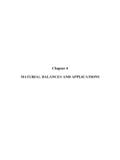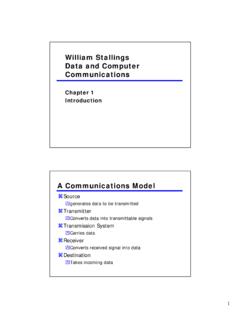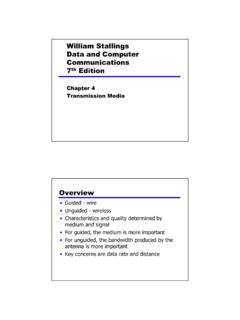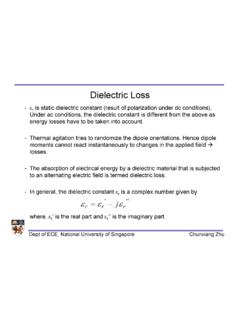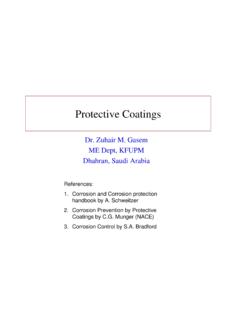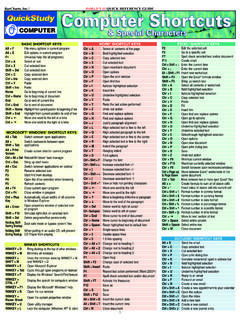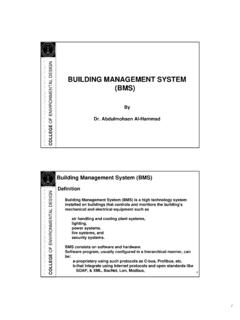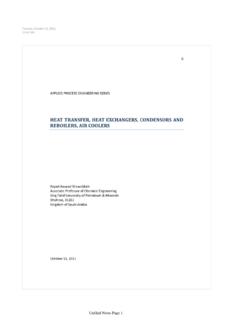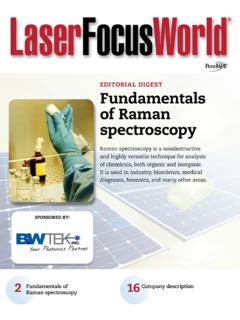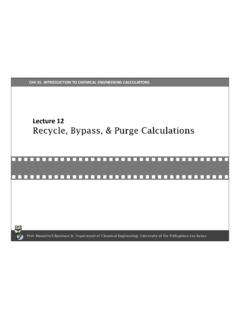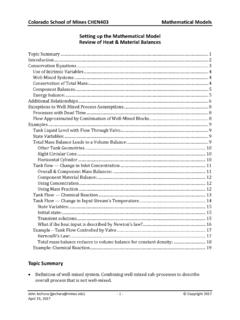Transcription of CHAPTER ONE THE GENERAL BALANCE EQUATION
1 material and energy BALANCES FOR ENGINEERS AND ENVIRONMENTALISTS Imperial College ONEER ONEER ONEER ONEER ONETHE GENERALTHE GENERALTHE GENERALTHE GENERALTHE GENERALBBBBBALAALAALAALAALANCENCENCENCEN CEEQEQEQEQEQUAUAUAUAUATTTTTIONIONIONIONI ONACC = In OuACC = In OuACC = In OuACC = In OuACC = In Out + Gt + Gt + Gt + Gt + Gen Conen Conen Conen Conen ConMATERIAL and energy BALANCES FOR ENGINEERS AND ENVIRONMENTALISTS Imperial College and energy Balances for Engineers and EnvironmentalistsTHE GENERAL BALANCEAll material and energy (M&E) BALANCE calculations are based on our experience that matter and energy maychange its form, but it cannot appear from nor disappear to nothing.
2 This observation is expressedmathematically in EQUATION , the GENERAL BALANCE a defined systemand a specified quantity:Accumulation=Input Output+Generation Consumptionin systemto systemfrom systemin systemin systemwhere:Accumulation =in systemInput=to systemOutput=from systemGeneration=in systemConsumption =in systemThe GENERAL BALANCE EQUATION ( EQUATION ) is a powerful EQUATION , which can be used in various ways tosolve many practical problems. Once you understand EQUATION the calculation of M&E balances issimply a matter of GENERAL BALANCE EQUATION ( EQUATION ) is the primary EQUATION that is repeated throughout this text.
3 Ineach CHAPTER where it appears, the first number of this EQUATION corresponds to the number of the CHAPTER , sothat it enters CHAPTER 4 as EQUATION , CHAPTER 5 as EQUATION and CHAPTER 7 as EQUATION time you apply EQUATION , you must begin by defining the system under consideration and thequantity of interest in the system. The system is a physical space, which is completely enclosed by a hypotheticalenvelope whose location exactly defines the extent of the system. The quantity may be any specified measurable(extensive1) property, such as the mass, moles,2 volume or energy content of one or more components of thesystem.
4 When EQUATION is applied to energy balances, the quantity also includes energy transfer acrossthe system envelope as heat and/or work (see CHAPTER 5). EQUATION [final amount of the quantity initial amount of the quantity] inside the system of the quantity entering the system through the system boundary.(input)amount of the quantity leaving the system through the system boundary.(output)amount of the quantity generated ( formed) inside the system boundary.(source)amount of the quantity consumed ( converted) inside the system boundary.
5 (sink)1An extensive property is a property whose value is proportional to the amount of is the amount of a substance containing the same number of elementary particles as there are atoms in kg ofcarbon 12 ( Avogadro s number = particles). The number of moles in a given quantity of a molecular species(or element) is its mass divided by its molar mass, n = m / M. For molecular and ionic compounds in chemical processes( H2O, H2, O2, CH4, NaCl) the elementary particles are molecules.
6 For unassociated elements and for ions the elementaryparticles are atoms ( C, Na+, Cl ) or charged groups of atoms ( NH4+, ClO ). Refer to a basic chemistry text for morecomprehensive information of atoms, ions, molecules and chemical and energy BALANCES FOR ENGINEERS AND ENVIRONMENTALISTS Imperial College 1 The GENERAL BALANCE Equation7 When you use the GENERAL BALANCE EQUATION it is best to begin with a conceptual diagram of the system,which clearly shows the complete system boundary plus the inputs and outputs of the system.
7 Figure isan example of such a diagram. Note that: Figure is a two-dimensional representation of a real three-dimensional system The system has a closed boundary The system may have singular or multiple inputs and/or outputsFigure Conceptual diagram of a AND CHANGING QUANTITIESThe GENERAL BALANCE EQUATION ( EQUATION ) applies to any extensive quantity. However, when you useEquation , it is helpful to distinguish between quantities that are conserved and quantities that are notconserved. A conserved quantity is a quantity whose total amount is maintained constant and is understoodto obey the principle of conservation, which states that such a quantity can be neither created nor , a conserved quantity is one whose total amount remains constant in an isolated system,3regardless of what changes occur inside the quantities that are conserved, the generation and consumption terms in EQUATION are both zero,whereas for quantities that are not conserved.
8 Either or both of the generation and consumption terms is isolated system is a hypothetical system that has zero interaction with its surroundings, zero transfer of material , heat, work,radiation, etc. across the BoundaryInputstoSystemOutputsfromSystemM ATERIAL and energy BALANCES FOR ENGINEERS AND ENVIRONMENTALISTS Imperial College and energy Balances for Engineers and EnvironmentalistsMATERIAL and energy BALANCESIn GENERAL , material and energy are equivalent through EQUATION = mc2 EQUATION :E = energyJm = mass ( the rest mass)kgc = velocity of light in vacuum = 3E8ms-1In a system where material and energy are inter-converted, EQUATION can thus be written for the quantity(mc2 + E) as.
9 Acc=In Out+Gen ConEquation (mc2+ E )(mc2+ E)(mc2+ E)(mc2+ E)(mc2+ E)in systemto systemfrom systemin systemin systemThe sum (mc2+ E) is a conserved quantity, so the generation and consumption terms in EQUATION thus reduces to EQUATION of (mc2+ E) = Input of (mc2+ E) Output of (mc2+ E) EQUATION systemto systemfrom systemEquation is a mathematical statement of the GENERAL principle of conservation of matter and energy thatapplies to all systems within human knowledge .4 Excluding processes in nuclear engineering, nuclear physics, nuclear weapons and radiochemistry, systemson earth do not involve significant inter-conversion of mass and energy .
10 In such non-nuclear systems,individual atomic species ( elements) as well as the total mass and total energy are independently individual atomic species in non-nuclear systems, EQUATION then reduces to EQUATION of atoms = Input of atoms Output of atomsEquation systemto systemfrom systemAlso, EQUATION can be written as two separate and independent equations , one for total mass( EQUATION ) and another for total energy ( EQUATION ).Accumulation of mass = Input of mass Output of massEquation systemto systemfrom system4 Modern cosmology may have more to say about the principle of conservation (see Ref.)
